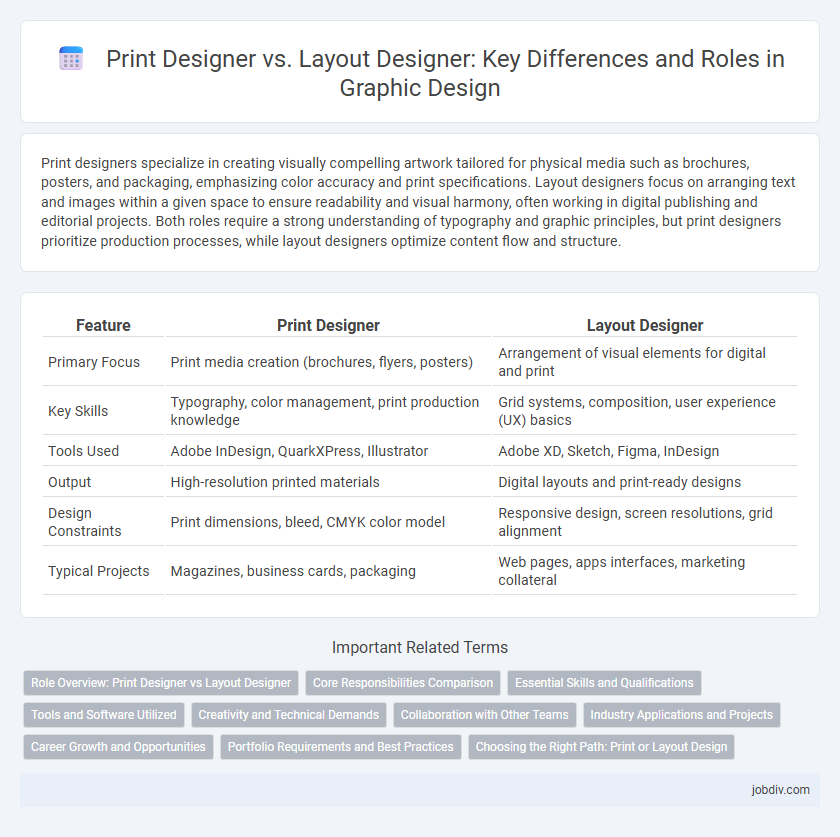Print designers specialize in creating visually compelling artwork tailored for physical media such as brochures, posters, and packaging, emphasizing color accuracy and print specifications. Layout designers focus on arranging text and images within a given space to ensure readability and visual harmony, often working in digital publishing and editorial projects. Both roles require a strong understanding of typography and graphic principles, but print designers prioritize production processes, while layout designers optimize content flow and structure.
Table of Comparison
| Feature | Print Designer | Layout Designer |
|---|---|---|
| Primary Focus | Print media creation (brochures, flyers, posters) | Arrangement of visual elements for digital and print |
| Key Skills | Typography, color management, print production knowledge | Grid systems, composition, user experience (UX) basics |
| Tools Used | Adobe InDesign, QuarkXPress, Illustrator | Adobe XD, Sketch, Figma, InDesign |
| Output | High-resolution printed materials | Digital layouts and print-ready designs |
| Design Constraints | Print dimensions, bleed, CMYK color model | Responsive design, screen resolutions, grid alignment |
| Typical Projects | Magazines, business cards, packaging | Web pages, apps interfaces, marketing collateral |
Role Overview: Print Designer vs Layout Designer
Print Designers specialize in creating visually compelling artwork tailored for physical media, utilizing expertise in color theory, typography, and print production processes to ensure high-quality outputs. Layout Designers focus on organizing text and images within digital or print formats, emphasizing readability, flow, and spatial hierarchy to enhance user engagement and communication effectiveness. Both roles collaborate closely but prioritize different aspects of design, with Print Designers aimed at material aesthetics and technical print requirements, while Layout Designers optimize structural composition and content alignment.
Core Responsibilities Comparison
Print designers specialize in creating visually appealing graphics and artwork tailored for physical media such as brochures, posters, and packaging, focusing on color accuracy, resolution, and print-ready file formats. Layout designers concentrate on structuring text and images within a page or digital interface, ensuring readability, alignment, and hierarchy for magazines, websites, or advertisements. While print designers prioritize print production specifics, layout designers emphasize spatial arrangement and user experience across various mediums.
Essential Skills and Qualifications
Print Designers excel in mastering color theory, typography, and print production processes, ensuring high-quality physical outputs, while Layout Designers specialize in digital composition, grid systems, and user experience to create visually balanced interfaces. Essential skills for Print Designers include proficiency in Adobe InDesign, Photoshop, and knowledge of CMYK color models, whereas Layout Designers require expertise in wireframing, responsive design, and tools like Sketch or Figma. Both roles demand strong attention to detail, creativity, and a solid understanding of design principles to effectively communicate visual messages.
Tools and Software Utilized
Print designers primarily use software like Adobe InDesign, Illustrator, and Photoshop to create high-resolution visuals for physical media, emphasizing color accuracy and print specifications. Layout designers also rely heavily on Adobe InDesign but may incorporate digital tools such as Sketch, Figma, or Adobe XD to optimize page arrangement for both print and digital platforms. Mastery of typography, grid systems, and color management software is essential for both roles to ensure precise and effective design execution.
Creativity and Technical Demands
Print designers emphasize creativity by crafting visually compelling graphics tailored for physical media, utilizing color theory and print production knowledge. Layout designers focus on technical demands, arranging elements with precision to ensure readability and optimal flow, integrating typography and spatial balance effectively. Both roles require mastery of design software, but print designers prioritize artistic expression while layout designers emphasize structural coherence.
Collaboration with Other Teams
Print Designers collaborate closely with marketing and production teams to ensure that visual elements align with brand guidelines and print specifications, optimizing color accuracy and material choices. Layout Designers work alongside editorial, UX, and digital teams to create structured, visually appealing page arrangements that enhance readability and user experience across multiple platforms. Both roles require seamless communication and project coordination to deliver cohesive and effective design solutions.
Industry Applications and Projects
Print designers specialize in creating visuals for physical media such as brochures, posters, and packaging, focusing on color accuracy and print resolution for industries like advertising, publishing, and marketing. Layout designers work primarily on digital or print formats, arranging text and images to optimize readability and aesthetic flow in projects including magazines, websites, and annual reports. Both roles intersect in branding projects but differ in tools and deliverables tailored to either print production or digital presentation environments.
Career Growth and Opportunities
Print designers specialize in creating visually compelling materials for physical media such as brochures, posters, and packaging, leveraging expertise in color theory and typography to enhance brand messaging. Layout designers focus on organizing content and graphics for both print and digital platforms, optimizing readability and user experience through masterful grid systems and spacing. Career growth for print designers often leads to roles in brand strategy and production management, while layout designers can advance into UX/UI design and digital media art direction, reflecting the evolving demand for cross-platform design skills.
Portfolio Requirements and Best Practices
Print designers should showcase a diverse portfolio featuring brochures, posters, and packaging that highlight attention to color accuracy, typography, and bleed settings. Layout designers must emphasize projects demonstrating grid systems, typographic hierarchy, and responsive design across digital and print media. Both portfolios benefit from clear annotations explaining design choices, software proficiency, and alignment with client branding goals.
Choosing the Right Path: Print or Layout Design
Print designers specialize in creating visually compelling materials for physical formats like brochures, posters, and packaging, emphasizing color accuracy and print production techniques. Layout designers focus on arranging content and visuals in digital or print media to enhance readability and aesthetic balance, often working with magazines, websites, and apps. Choosing the right path depends on your interest in hands-on print processes versus digital content arrangement and user experience optimization.
Print Designer vs Layout Designer Infographic

 jobdiv.com
jobdiv.com